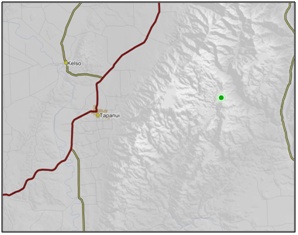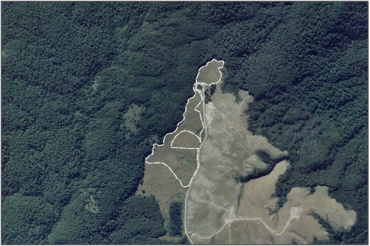-
-
-
-
-
-
-
-
-
-
John O'Groats Hill Fen
-
-
-
-
-
-
-
-
-
-
-
-
-
-
-
-
-
-
-
-
-
John O'Groats Hill Fen
Description:
Area of copper tussock swamp at the head of the West Branch of Back Stream, adjacent to John O’Groats Hill, on the east side of the Blue Mountains.
Type/Class:
Fen.
Size:
22.5 ha.
Altitude:
300 - 600 m above sea level.
Approximate location:
6.3 km Northwest of the intersection of Blackcleugh Road and Rongahere Road, Lawrence.
NZTM (centre point): E1322560 N4910650.
Regional Plan:
Schedule 9 Regionally Significant Wetland, no.67, Map F28.
Territorial Authority:
Clutha District Council.


Aerial View of John O'Groats Hill Fen (March 2006)
Recorded Values:
Value |
Description |
|---|---|
| A4 | High degree of wetland naturalness. 2 |
| A5 | Scarce in Otago in terms of its ecological or physical character. Less than 15% of swamps remain in Otago. 2 |
| A7 | High diversity of indigenous flora and fauna. High species diversity: copper tussock and a wide range of shrubs, herbs and invertebrate species. 1 |
Other Information:
- The northern portion is red tussock wetland, while the southern portion, has "true wetland" along the stream. The majority of the area is damp red tussockland, with some shrubland. The red tussockland forms an important buffer to the wetland. The entire area is considered to have conservation value. 101
- Native plant species recorded during a survey of the wetland in December 2009 include Aciphylla scott-thomsonii, Anaphaloides bellidioides, Aporostylis bifolia, Astelia nervosa, Blechnum montanum, Blechnum penna-marina, Blechnum procerum, Carex coriacea, Carex tenuiculmis, Carex sp., Celmisia glandulosa, Celmisia gracilenta, Celmisia graminifolia, Chionochloa rubra, Coprosma cheesemanii, Coprosma dumosa, Coprosma propinqua, Coprosma tayloriae, Cortaderia richardii, Dracophyllum longifolium, Gaultheria macrostigma, Geranium microphyllum, Gentiana grisebachii, Gonocarpus micranthus, Hebe odora, Hebe salicifolia, Helichrysum filicaule, Hierochloe redolens, Histeopteris incise, Hypolepis millefolium, Juncus edgariae, Juncus novae-zelandiae, Leptospermum scoparium, Lobelia angulata, Lycopodium fastigiatum, Montia Fontana, Nertera depressa, Nertera setulosa, Olearia bullata, Oreomyrrhis ramose, Oreostylidium subulatum, Ozothamnus vauvilliersii, Phormium tenax, Polystichum vestitum, Pteridium esculentum, Rytidosperma gracile, Ranunculus foliosus, Ranunculus ternatifolius, Raukaua simplex, Stellaria parviflora, Uncinia rubra, Uncinia sp, Viola cunninghamii. 85
- Introduced plant species recorded during a survey in December 2009 include Agrostis capillaries, Anthoxanthum odoratum, Cerastium fontanum, Crepis capillaries, Cyatsus scoparius, Digitalis purpurea, Hieracium pilosella, Holcus lanatus, Hypochaeris radicata, Juncus effuses, Lotus pedunculatus, Pinus contorta, Poa pratense, Taraxacum officinale, Trifolium repens. 85
References:
1 Otago Regional Council (2004) Regional Plan: Water for Otago. Published by the Otago Regional Council, Dunedin.
2 Ausseil, A.G., Newsome, P., Johnson, P. (2008) Wetland Mapping in the Otago Region. Landcare Research Contract Report prepared for the Otago Regional Council.
85 Correspondence with Department of Conservation – Southland Conservancy (2011) Document ID A389679.
101 Correspondence with Department of Conservation – Southland Conservancy (2010) Document ID A194008.
